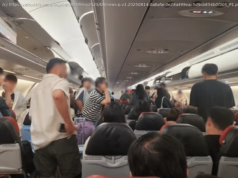min Park and Soyoung Kim
The launches, the latest in a fast-paced series of missile tests by North Korea defying world pressure to rein in its weapons program, come less than a week after the United Nations Security Council passed fresh sanctions on the reclusive state. (Graphic — Nuclear North Korea tmsnrt.rs/2lE5yjF)
South Korea on Wednesday said it will hold off on installing remaining components of the U. S. Terminal High Altitude Area Defense (THAAD) system that has angered North Korea’s main ally, China, amid early signs of easing tensions between the two countries.
U. S. President Donald Trump, Defense Secretary Jim Mattis and Secretary of State Rex Tillerson discussed the Korean situation, including THAAD, at the White House on Thursday, State Department spokeswoman Heather Nauert told a news briefing.
North Korea missile launches showed that THAAD was «important to, not only to protect U. S. forces, to protect our alliance and to … help to further strengthen the region, » Nauert said.
«We are aware, certainly, of the situation and the suspension of additional launchers, » she said. «We would continue to say that THAAD was an alliance decision at the time, and we continue to work closely with (South Korea) throughout their process.»
Nauert called the latest North Korean missile launches «provocative.»
The missiles were launched Thursday morning from the North Korean coastal city of Wonsan and flew about 200 km (124 miles) , South Korea’s Office of Joint Chiefs of Staff said.
Under third-generation leader Kim Jong Un, North Korea has been conducting missile tests at an unprecedented pace in an effort to develop an intercontinental ballistic missile capable of hitting the mainland United States.
Compared to the different types of ballistic missiles Pyongyang has recently tested, the missiles launched on Thursday are considered to be more defensive in nature, designed to defend against threats such as enemy warships.
North Korea unveiled a number of new weapons at a massive military parade on April 15 to mark the birth anniversary of the state’s founding leader and has since tested some of them.
«What appeared to be a new type of land-to-ship missile equipped with four launching canisters was unveiled at the parade, » said Kim Dong-yub, a military expert at Kyungnam University’s Far Eastern Studies in Seoul. «I think this might be what was used today.»
Thursday’s launch is the fourth missile test by North Korea since South Korean President Moon Jae-in took office on May 10 pledging to engage in dialogue with Pyongyang. He says sanctions and pressure alone have failed to resolve the growing North Korean threat.
North Korea has conducted dozens of missile tests and tested two nuclear bombs since the beginning of 2016 in defiance of U. N. Security Council resolutions. It says its weapons programs are necessary to counter U. S. aggression.
Moon had also promised to review the deployment of the THAAD system in South Korea, a decision that was made by the government of his conservative predecessor, Park Geun-hye. On Wednesday, Moon’s office said installation of four additional launchers would be halted until an assessment of the system’s impact on the environment was completed.
Two launchers of the full six-launcher THAAD battery, as well as the system’s far-reaching radar that China worries could upset the regional security balance, have already been installed at a deployment site in the southeastern city of Seongju. The elements will stay in place, South Korea said.
The introduction of the THAAD system has sparked protests in South Korea and a backlash in China against South Korean business interests.
The Global Times, published by China’s official People’s Daily, said in an editorial that no matter the outcome of the environmental study, South Korea’s announcement could reduce friction.
«Obviously, the pressure China puts on South Korea has taken effect. Seoul’s will has been shaken, » the paper said. «However, attitude is not everything. Without solving the problem of THAAD, the pain it has brought to bilateral relations will not disappear, and South Korea must swallow some of the bitter results.»
China should work with Russia on counter-measures to THAAD, the Global Times added.
Asked about the latest missile test, Chinese Foreign Ministry spokeswoman Hua Chunying called for all parties to exercise restraint.
«The UN Security Council resolution has clear rules on (North Korea’s) use of ballistic missiles technologies, » she said. «All sides should work together to de-escalate tensions and take active steps to stabilize the region.»
Trump has been pressing China to rein in North Korea, warning that all options, including a pre-emptive military strike, are on the table if Pyongyang persists with its nuclear and missile development.
Seoul, Tokyo and Washington were analyzing the launches for further information, officials said.
Japan’s navy and air force conducted military drills with two U. S. aircraft carriers in the Sea of Japan last week, following similar joint U. S.-South Korea exercises.
«North Korea likely wanted to show off its ability to precisely target a large warship, in relation to the joint military drills involving U. S. aircraft carriers, » Roh Jae-cheon, South Korea’s Joint Chiefs of Staff spokesman, told a media briefing.
«By testing different types of missiles, North Korea also appears to be aiming to secure the upper hand in relations with South Korea and the United States.»
(Additional reporting by Christine Kim in Seoul, Christian Shepherd and Ben Blanchard in Beijing and David Brunnstrom in Washington; Editing by Lincoln Feast and Leslie Adler)
Домой
United States
USA — Korea North Korea fires suspected land-to-ship missiles as South Korea delays THAAD






